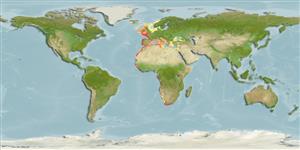Actinopterygii (ray-finned fishes) >
Perciformes (Perch-likes) >
Carangidae (Jacks and pompanos) > Caranginae
Etymology: Trachurus: Greek, trachys, -eia, -ys = rough + Greek, oura = tail (Ref. 45335).
Environment / Climate / Range
Ecology
Marine; pelagic-neritic; oceanodromous (Ref. 51243); depth range 0 - 1050 m (Ref. 54256), usually 100 - 200 m (Ref. 54256). Subtropical, preferred 17°C (Ref. 107945); 67°N - 19°S, 26°W - 41°E (Ref. 54256)
Mediterranean Sea and eastern Atlantic: Norway to South Africa, round the coast to Maputo.
Length at first maturity / Size / Weight / Age
Maturity: Lm 23.9, range 21 - 30 cm
Max length : 70.0 cm TL male/unsexed; (Ref. 3197); common length : 22.0 cm FL male/unsexed; (Ref. 3397); max. published weight: 2.0 kg (Ref. 27584)
Dorsal
spines
(total): 9;
Dorsal
soft rays
(total): 30-36;
Anal
spines: 3;
Anal
soft rays: 24 - 32. Bluish green, grey or black above, silvery white below; opercle with black spot (Ref. 3197). Lateral scales tall and keeled. Gill cover with a distinct black spot. First dorsal fin tall (Ref. 35388).
Adults form large schools in coastal areas with sandy substrate. They feed on fish, crustaceans, and cephalopods. Are batch spawners (Ref. 51846). Females lay 140,000 eggs, which hatch into 5mm long larvae (Ref. 35388). Eggs are pelagic (Ref. 4233). Utilized fresh, smoked, canned and frozen; can be fried, broiled and baked (Ref. 9988). Divided into two stocks: West stock and North Sea stock. West stock spawns in a belt from the Biscay to Ireland in early spring, migrates north and eastwards to southern Norway and northern North Sea. North Sea stock spawns in the southern North Sea in summer, migrates to central North Sea, Skagerrak and Kattegat.
Smith-Vaniz, W.F., 1986. Carangidae. p. 815-844. In P.J.P. Whitehead, M.-L. Bauchot, J.-C. Hureau, J. Nielsen and E. Tortonese (eds.) Fishes of the north-eastern Atlantic and the Mediterranean. UNESCO, Paris. vol. 2. (Ref. 4233)
IUCN Red List Status (Ref. 115185)
CITES (Ref. 94142)
Not Evaluated
Threat to humans
Harmless
Human uses
Fisheries: highly commercial; gamefish: yes; bait: usually
Tools
Special reports
Download XML
Internet sources
Estimates of some properties based on models
Phylogenetic diversity index (Ref.
82805): PD
50 = 0.5001 [Uniqueness, from 0.5 = low to 2.0 = high].
Bayesian length-weight: a=0.00832 (0.00754 - 0.00918), b=2.96 (2.93 - 2.99), in cm Total Length, based on LWR estimates for this species (Ref.
93245).
Trophic Level (Ref.
69278): 3.7 ±0.0 se; Based on diet studies.
Resilience (Ref.
69278): Medium, minimum population doubling time 1.4 - 4.4 years (K=0.12-0.16; tm=2-4; tmax=11; Fec=70,000).
Prior r = 0.47, 2 SD range = 0.22 - 0.98, log(r) = -0.76, SD log(r) = 0.37, Based on: 25 K, 17 tgen, 19 Fec records
Vulnerability (Ref.
59153): High vulnerability (59 of 100) .
